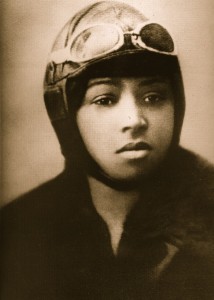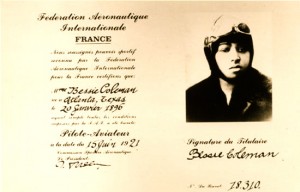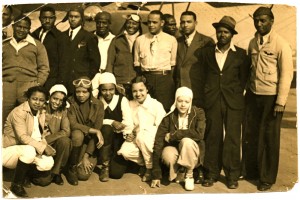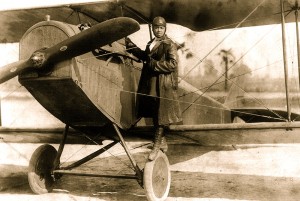Bessie Coleman
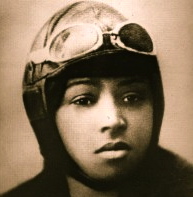
Bessie Coleman
A video chronicling the life of Bessie Coleman, the first African-American female pilot.
Elizabeth “Bessie” Coleman (January 26, 1892 – April 30, 1926) was an American civil aviator. She was the first female pilot of African American descent and the first person of African-American descent to hold an international pilot license.
Early Life
Coleman was born on January 26, 1892, in Atlanta, Texas, the tenth of thirteen children to sharecroppers George, who was part Cherokee, and Susan Coleman. When Coleman was two years old, her family moved to Waxahachie, Texas, where she lived until age 23. Coleman began attending school in Waxahachie at age six and had to walk four miles each day to her segregated, one-room school, where she loved to read and established herself as an outstanding math student. She completed all eight grades of her one-room school. Every year, Coleman’s routine of school, chores, and church was interrupted by the cotton harvest. In 1901, Coleman’s life took a dramatic turn: George Coleman left his family. He returned to Oklahoma, or Indian Territory as it was then called, to find better opportunities, but Susan and the children did not go with him. At age 12, Bessie was accepted into the Missionary Baptist Church. When she turned eighteen, she took her savings and enrolled in the Oklahoma Colored Agricultural and Normal University (now called Langston University) in Langston, Oklahoma. She completed one term before her money ran out, and she returned home.
Career – Chicago
In 1916 at the age of 23, she moved to Chicago, Illinois, where she lived with her brothers and she worked at the White Sox Barber Shop as a manicurist, where she heard stories from pilots returning home from World War 1 about flying during the war. She could not gain admission to American flight schools because she was black and a woman. No black U.S. aviator would train her either. Robert S. Abbott, founder and publisher of the Chicago Defender, encouraged her to study abroad. Coleman received financial backing from banker Jesse Binga and the Defender.
France
Coleman took a French-language class at the Berlitz school in Chicago, and then traveled to Paris on November 20, 1920, so she could earn her pilot license. She learned to fly in a Nieuport Type 82 biplane, with “a steering system that consisted of a vertical stick the thickness of a baseball bat in front of the pilot and a rudder bar under the pilot’s feet.” On June 15, 1921, Coleman became not only the first woman of African-American descent to earn an international aviation license from the Fédération Aéronautique Internationale, and the first American of any gender or ethnicity to do so, but the first woman of African-American descent to earn an aviation pilot’s license. Determined to polish her skills, Coleman spent the next two months taking lessons from a French ace pilot near Paris, and in September 1921, she sailed for New York. She became a media sensation when she returned to the United States.
Orlando
In the 1920″s, in Orlando on a speaking tour, she met the Rev. Hezakiah Hill and his wife Viola, community activists who invited her to stay with them at the parsonage of Mount Zion Missionary Baptist Church on Washington Street in the neighborhood of Parramore. A local street was renamed “Bessie Coleman” Street in her honor in 2015. The couple, who treated her as a daughter, persuaded her to stay and Bessie opened a beauty shop in Orlando to earn extra money to buy her own plane.
Airshows
Coleman quickly realized that in order to make a living as a civilian aviator—the age of commercial flight was still a decade or more in the future—she would need to become a “barnstorming” stunt flier, and perform for paying audiences. But to succeed in this highly competitive arena, she would need advanced lessons and a more extensive repertoire. Returning to Chicago, Coleman could find no one willing to teach her, so in February 1922, she sailed again for Europe. She spent the next two months in France completing an advanced course in aviation, then left for the Netherlands to meet with Anthony Fokker, one of the world’s most distinguished aircraft designers. She also traveled to Germany, where she visited the Fokker Corporation and received additional training from one of the company’s chief pilots. She returned to the United States with the confidence and enthusiasm she needed to launch her career in exhibition flying.
“Queen Bess,” as she was known, was a highly popular draw for the next five years. Invited to important events and often interviewed by newspapers, she was admired by both blacks and whites. She primarily flew Curtiss JN-4 “Jenny” biplanes and army surplus aircraft left over from the war. She made her first appearance in an American airshow on September 3, 1922, at an event honoring veterans of the all-black 369th Infantry Regiment of World War I. Held at Curtiss Field on Long Island near New York City and sponsored by her friend Abbott and the Chicago Defender newspaper, the show billed Coleman as “the world’s greatest woman flier” and featured aerial displays by eight other American ace pilots, and a jump by black parachutist Hubert Julian. Six weeks later she returned to Chicago to deliver a stunning demonstration of daredevil maneuvers—including figure eights, loops, and near-ground dips—to a large and enthusiastic crowd at the Checkerboard Airdrome (now Chicago Midway Airport).
But the thrill of stunt flying and the admiration of cheering crowds were only part of Coleman’s dream. Coleman never lost sight of her childhood vow to one day “amount to something.” As a professional aviator, Coleman would often be criticized by the press for her opportunistic nature and the flamboyant style she brought to her exhibition flying. However, she also quickly gained a reputation as a skilled and daring pilot who would stop at nothing to complete a difficult stunt. In Los Angeles, she broke a leg and three ribs when her plane stalled and crashed on February 22, 1923.
Through her media contacts, she was offered a role in a feature-length film titled Shadow and Sunshine, to be financed by the African American Seminole Film Producing Company. She gladly accepted, hoping the publicity would help to advance her career and provide her with some of the money she needed to establish her own flying school. But upon learning that the first scene in the movie required her to appear in tattered clothes, with a walking stick and a pack on her back, she refused to proceed. “Clearly … [Bessie’s] walking off the movie set was a statement of principle. Opportunist though she was about her career, she was never an opportunist about race. She had no intention of perpetuating the derogatory image most whites had of most blacks,” wrote Doris Rich.
Coleman would not live long enough to fulfill her dream of establishing a school for young black aviators, but her pioneering achievements served as an inspiration for a generation of African American men and women. “Because of Bessie Coleman,” wrote Lieutenant William J. Powell in Black Wings 1934, dedicated to Coleman, “we have overcome that which was worse than racial barriers. We have overcome the barriers within ourselves and dared to dream.” Powell served in a segregated unit during World War I, and tirelessly promoted the cause of black aviation through his book, his journals, and the Bessie Coleman Aero Club, which he founded in 1929.
Death
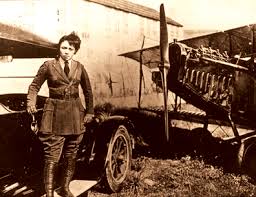 Her daredevil stunts and hair raising maneuvers earned her the name “Brave Bessie”
Her daredevil stunts and hair raising maneuvers earned her the name “Brave Bessie”
On April 30, 1926, Coleman was in Jacksonville, Florida. She had recently purchased a Curtiss JN-4 (Jenny) in Dallas. Her mechanic and publicity agent, William Wills, flew the plane from Dallas in preparation for an airshow but had to make three forced landings along the way due to the plane’s being so poorly maintained and worn out. Upon learning this, Coleman’s friends and family did not consider the aircraft safe and implored her not to fly it. On take-off, Wills was flying the plane with Coleman in the other seat. She had not put on her seatbelt because she was planning a parachute jump for the next day and wanted to look over the cockpit sill to examine the terrain. About ten minutes into the flight, the plane unexpectedly dived, then spun around. Coleman was thrown from the plane at 2,000 ft (610 m) and died instantly when she hit the ground. William Wills was unable to regain control of the plane and it plummeted to the ground. Wills died upon impact and the plane burst into flames. Although the wreckage of the plane was badly burned, it was later discovered that a wrench used to service the engine had slid into the gearbox and jammed it. Coleman was just 34 years old.
Honors
A public library in Chicago was named in Coleman’s honor, as well as roads at O’Hare International Airport in Chicago, Oakland International Airport in Oakland, California, and at Frankfurt International Airport.
Bessie Coleman Middle School in Cedar Hill, Texas is named for her.
Bessie Coleman Boulevard in Waxahachie, Texas, (where she lived as a child) is named in her honor.
B. Coleman Aviation, a Fixed Base Operator based at Gary/Chicago International Airport is named in her honor.
Several Bessie Coleman Scholarship Awards have been established for high school seniors planning on careers in aviation.
The U.S. Postal Service issued a 32-cent stamp honoring Coleman in 1995. The Bessie Coleman Commemorative is the 18th in the U.S. Postal Service Black Heritage series.
In 2006, she was inducted into the National Aviation Hall of Fame, arguably aviation’s most prestigious honor.
In 2012, a bronze plaque with Coleman’s likeness was installed on the front doors of Paxon School for Advanced Studies located on the site of the Jacksonville airfield where Coleman’s fatal flight took off. She was placed at No. 14 on Flying Magazine’s 2013 list of the “51 Heroes of Aviation.”

